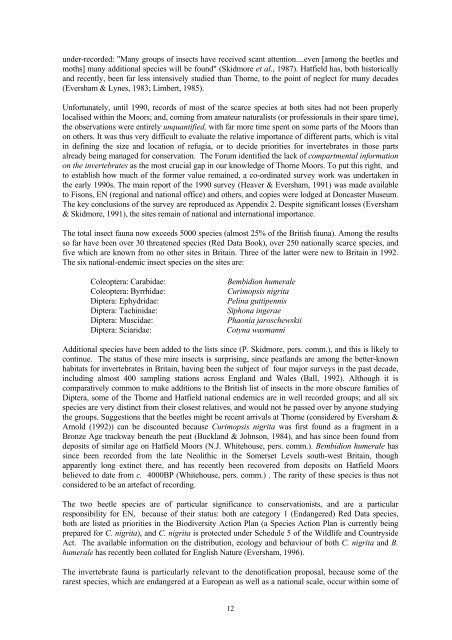free download - Thorne & Hatfield Conservation Forum
free download - Thorne & Hatfield Conservation Forum
free download - Thorne & Hatfield Conservation Forum
Create successful ePaper yourself
Turn your PDF publications into a flip-book with our unique Google optimized e-Paper software.
under-recorded: "Many groups of insects have received scant attention....even [among the beetles and<br />
moths] many additional species will be found" (Skidmore et al., 1987). <strong>Hatfield</strong> has, both historically<br />
and recently, been far less intensively studied than <strong>Thorne</strong>, to the point of neglect for many decades<br />
(Eversham & Lynes, 1983; Limbert, 1985).<br />
Unfortunately, until 1990, records of most of the scarce species at both sites had not been properly<br />
localised within the Moors; and, coming from amateur naturalists (or professionals in their spare time),<br />
the observations were entirely unquantified, with far more time spent on some parts of the Moors than<br />
on others. It was thus very difficult to evaluate the relative importance of different parts, which is vital<br />
in defining the size and location of refugia, or to decide priorities for invertebrates in those parts<br />
already being managed for conservation. The <strong>Forum</strong> identified the lack of compartmental information<br />
on the invertebrates as the most crucial gap in our knowledge of <strong>Thorne</strong> Moors. To put this right, and<br />
to establish how much of the former value remained, a co-ordinated survey work was undertaken in<br />
the early 1990s. The main report of the 1990 survey (Heaver & Eversham, 1991) was made available<br />
to Fisons, EN (regional and national office) and others, and copies were lodged at Doncaster Museum.<br />
The key conclusions of the survey are reproduced as Appendix 2. Despite significant losses (Eversham<br />
& Skidmore, 1991), the sites remain of national and international importance.<br />
The total insect fauna now exceeds 5000 species (almost 25% of the British fauna). Among the results<br />
so far have been over 30 threatened species (Red Data Book), over 250 nationally scarce species, and<br />
five which are known from no other sites in Britain. Three of the latter were new to Britain in 1992.<br />
The six national-endemic insect species on the sites are:<br />
Coleoptera: Carabidae: Bembidion humerale<br />
Coleoptera: Byrrhidae: Curimopsis nigrita<br />
Diptera: Ephydridae: Pelina guttipennis<br />
Diptera: Tachinidae: Siphona ingerae<br />
Diptera: Muscidae: Phaonia jaroschewskii<br />
Diptera: Sciaridae: Cotyna wasmanni<br />
Additional species have been added to the lists since (P. Skidmore, pers. comm.), and this is likely to<br />
continue. The status of these mire insects is surprising, since peatlands are among the better-known<br />
habitats for invertebrates in Britain, having been the subject of four major surveys in the past decade,<br />
including almost 400 sampling stations across England and Wales (Ball, 1992). Although it is<br />
comparatively common to make additions to the British list of insects in the more obscure families of<br />
Diptera, some of the <strong>Thorne</strong> and <strong>Hatfield</strong> national endemics are in well recorded groups; and all six<br />
species are very distinct from their closest relatives, and would not be passed over by anyone studying<br />
the groups. Suggestions that the beetles might be recent arrivals at <strong>Thorne</strong> (considered by Eversham &<br />
Arnold (1992)) can be discounted because Curimopsis nigrita was first found as a fragment in a<br />
Bronze Age trackway beneath the peat (Buckland & Johnson, 1984), and has since been found from<br />
deposits of similar age on <strong>Hatfield</strong> Moors (N.J. Whitehouse, pers. comm.). Bembidion humerale has<br />
since been recorded from the late Neolithic in the Somerset Levels south-west Britain, though<br />
apparently long extinct there, and has recently been recovered from deposits on <strong>Hatfield</strong> Moors<br />
believed to date from c. 4000BP (Whitehouse, pers. comm.) . The rarity of these species is thus not<br />
considered to be an artefact of recording.<br />
The two beetle species are of particular significance to conservationists, and are a particular<br />
responsibility for EN, because of their status: both are category 1 (Endangered) Red Data species,<br />
both are listed as priorities in the Biodiversity Action Plan (a Species Action Plan is currently being<br />
prepared for C. nigrita), and C. nigrita is protected under Schedule 5 of the Wildlife and Countryside<br />
Act. The available information on the distribution, ecology and behaviour of both C. nigrita and B.<br />
humerale has recently been collated for English Nature (Eversham, 1996).<br />
The invertebrate fauna is particularly relevant to the denotification proposal, because some of the<br />
rarest species, which are endangered at a European as well as a national scale, occur within some of<br />
12


